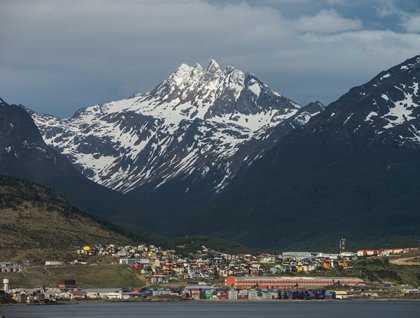We had departed Ushuaia yesterday evening witnessing the setting sun drop behind the mountains that provide such a dramatic backdrop to this most southerly town. Beside the coast road, in large capital letters on the roadside embankment, there was an unmissable sign declaring Ushuaia as the capital of the Malvinas, the Spanish name for our overnight destination, the Falkland Islands. Sailing conditions were near perfect and as we awoke for a leisurely breakfast in spring sunshine en route to a thinly populated archipelago to the east of the southern tip of South America the sovereignty of which is still disputed.
The problem is how to define sovereignty. We might look at who discovered the islands. As far as European explorers are concerned, the archipelago was probably sighted by Amerigo Vespucci in 1502, and we have enigmatic references to an archipelago in this vicinity from the log books of Magellan’s voyage of circumnavigation in 1520. John Davis aboard Desire probably sighted the archipelago in 1592. We know that Breton fishermen from St Malo fished in these waters, and the great French voyage of circumnavigation led by Louis Antoine Bougainville in 1766-69 put the islands on the charts as Les Malouines, commemorating St Malo. If we look at who first settled the islands, the French have a good claim as far as Europeans are concerned establishing Port Louis on East Falkland in 1764. A Franco-Spanish accord subsequently saw the French settlers withdraw and the town was renamed Puerto Soledad. In Spanish, Les Malouines was pronounced, “Las Malvinas.” Apparently unaware of the Franco-Spanish Accord, Captain Byron aboard HMS Welfare chose to name the island after the then first lord of the Admiralty, Viscount Falkland in 1690 and ordered the Spanish settlers to leave.
Of course, all these accounts of discovery and settlement are very Eurocentric. The existence in historic times of the warra or wolf-fox (dusicyon autralis) and of an isolated (and therefore archaeologically problematic) projectile point from Steeple Jason in the westerly Jason Islands hint at the possibility of the arrival here of some canoe Indians (Yahgan) following what would have been an epic voyage.
At the beginning of the nineteenth century the archipelago was largely unpopulated. As far as long-lasting continuous settlement on the islands is concerned, that dates from 1833 when Captain Onslow aboard HMS Clio took possession of the Falklands for Great Britain appointing Lt Col Henry Smith as the first governor of the Falkland Islands. A British settlement was established at Stanley and the islands have been continuously occupied by people of British descent since that time.
But was this British settlement confirmed by international treaty? Here there are further complications. In the year following the epoch-making Columbus voyage, the two rival maritime powers of Spain and Portugal appealed for arbitration to the Pope, as was the right of Catholic monarchs, in respect of their rival territorial claims in the New World. The Treaty of Tordesillas divided the New World between them, with the Falkland Islands falling in the Spanish sector, a treaty subsequently confirmed in the Treaty of Utrecht in 1713. So depending how one wishes to define sovereignty, Argentina (who inherited the Tordesillas claim following independence from Spain in 1816) and Britain can both lay claim to the islands. When we arrive tomorrow we shall see what all the fuss is about.







